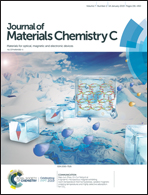Water-stable organic field-effect transistors based on naphthodithieno[3,2-b]thiophene derivatives†
Abstract
In the research field of biosensors, a fundamental difficulty for the applications of organic field-effect transistors (OFETs) is the stability to water and oxygen dissolved in aqueous system. Herein, we report water-stable transistors that adopt a bottom-gate bottom-contact configuration based on naphthodithieno[3,2-b]thiophene derivatives NDTT-8 or NDTT-10, which contain two long alkoxyl side chains. In comparison to pentacene and PDVT-10 polymer-based transistors, devices based on NDTT derivatives showed excellent water stabilities, which are among the best results for water-stable OFETs reported to date. After 90 days in water, the carrier mobility was still maintained at more than 50%. Systematic spectroscopy characterizations on the organic semiconducting layer were carried out and a possible mechanism for the high water stability was proposed. The alkoxyl groups in NDTT-8 and NDTT-10 molecules were responsible for better water stabilities of their OFET devices because the long hydrophobic side chains can effectively prevent water from spreading to the interface between the organic semiconducting layer and the insulating layer.
![Graphical abstract: Water-stable organic field-effect transistors based on naphthodithieno[3,2-b]thiophene derivatives](/en/Image/Get?imageInfo.ImageType=GA&imageInfo.ImageIdentifier.ManuscriptID=C8TC04999H&imageInfo.ImageIdentifier.Year=2019)


 Please wait while we load your content...
Please wait while we load your content...